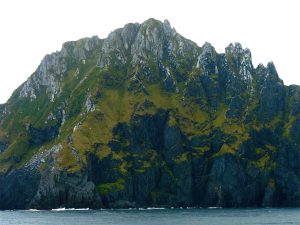By Professor Robert Fleming
I am the albatross that waits for you
at the end of the world.
I am the forgotten souls of dead mariners
who passed Cape Horn
from all the oceans of the earth.
But they did not die
in the furious waves.
Today they sail on my wings
toward eternity,
in the last crack
of Antarctic winds.
– Sara Vial
A world of wind, waves, and swirling spray is home to the albatrosses of the Southern Ocean, the birds a fitting symbol for the spirits of the many mariners who have perished attempting to sail around Cape Horn (Cabo de Hornos) at the tip of South America. These roiling seas hostmany oceanic birds including petrels, skuas, and shearwaters, but the primier species are albatrosses, their seemingly effortless flight beautifully adapted to the circumpolar winds that continuously blow east between 40 degrees and 60 degrees south latitude. Beneath the ocean’s surface, the Antarctic Circumpolar Current also circles east, little impeded by any land mass except where it has to squeeze through the 800km-wide Drake Passage between the Antarctic Peninsula and South America.

Cape Horn Island as seen when approaching from the south.
Of the 22 species of albatrosses in the world, 18 live here in the south, with many of the birds staying at sea for most of their lives and coming to land only to nest. For example, once a Wandering Albatross, with long, narrow wings that may reach up to 3.5m/11.6ft from tip to tip, has left its natal island the bird may spend four or five years at sea before again touching land. And much of this time is spent aloft, riding the wind currents while occasionally diving down to snatch a morsel from the oceans surface.
Albatosses have an elbow-locking mechanism, which, when combined with an acute neuro-muscular system finely tuned to air pressures, allows them to stay aloft for long periods with very little effort. Foreward movement is generated through a pattern of ‘dynamic soaring’, alternatively facing into the wind to gain height and then turning with the wind and diving back to near surface level, skimming the waves while constantly making adjustments with their long wings. It is reported that the birds can even sleep while aloft, and some individuals fitted with monitors have been recorded to cover over 64,000km/40,000mi in a year, circling the globe in less than 50 days.

A Black-browed Albatross
One might think of the Southern Ocean as a region mostly devoid of human activity. Far from it, and as a consequence, most albatrosses are now on the list of threatened species, with seventeen species possibly facing extinction. This dire predicament is due to multiple reasons, none of which involve hunting or running into ships when asleep. A primary problem is that they become entangled in long-line fishing operations. An albatross diet consists mostly of squid and fish, and if a bird sees potential food caught on a long line, they may dive down and themselves become entangled. Another factor is inadvertant ingestion of flotsam leading to a gut choked with plastic. And yet a third threat is reduced food availablity due to the overharvesting of krill on which fish feed. And on some islands a fourth factor is predation at nests by introduced rodents, especially mice, which pounce on nestlngs and even attack brooding adults. All these problems are being addressed though a Global Seabird Programme and several similar efforts. We can only hope it is not too late.

A Giant Fulmar, the other long-winged group of birds around the Cape.
When standing on the deck of a vessel plowing northward through the choppy waters of the Drake Passage, all the while braced against the wind and the rolling and pitching deck, the view is of an endless expanse of white-capped waves, their tops blown east into long, delicate wisps, and with the occasional albatross or petrel effortlessly passing by. However, upon nearing 56 degrees S, the seas on the northern horizon are interrupted by a squat, triangular speck – a first sighting of Cabos de Hornos, or the island of Cape Horn. From this distance, the Cape, as seen through binoculars, appears to be an imposing outcrop of bare rock with sheer cliffs fronting the south. However, on edging closer, a distinct greenish flush outlines the ridge tops, indicating that despite continuous winds, considerable cloud cover, and occasional fierce storms, the island is home to a variety of low-growing plants.

Cape Horn Island, looking west
Cape Horn is often thought of as the southern tip of the South American continent but since the rising of ocean waters after the last ice age the contiguous landmass of the continent ends at the Straits of Magellan. South of here lies a series of islands of which Cape Horn and Diego Ramirez Islands are the southernmost.

Nesting Gray-headed Albatrosses. This species nests on the Diego Ramirez Islands near Cape Horn, but this image was taken on South Georgia Island.
To have a close look at the natural history of Cape Horn involves disembarking from a passing vessel, but this is problematic at the best of times. However, if one is fortunate, a relatively calm spell does allow an occasional landing on a platform fixed to rock on the northern shore of the island. From here a short stairway gives access to a low eastern shoulder, and once atop the stairway, a gradual, undulating slope covered with vegetation leads up to the the ridge from where there is an unobstructed, southward view of the ocean.
No trees manage to take root on this wind-swept ridge, so the most dramatic vertical sight is two pieces of steel that appear to be planted into the ground along the ridge top. Why here? And with what purpose? From most directions, this sculpture appears to be a misplaced abstract piece of art, but if viewed from the approriate angle, just when the two separate sections seem to touch each other, the space between the plates, the open sky, cleverly outlines a soaring albatross. This superb memorial by Jose Balcalls, erected in 1992, is a fitting complement to the words of poet Sara Vial given above. Indeed, the souls of the departed sailors seem to soar in the wind with the albatrosses.

The Albatross Memorial
While Cape Horn is treeless, small bushes, many of them Hebes, take root in areas slightly sheltered from the wind. In addition, other plants take root here, including White Ragwort (Senecio), wild Celery (Apium), and Pig Vine (Gunnera), as well as low growing cushion plants, grasses, and mosses. During our visit in January, we found six species of plants in bloom and curiously the blossoms of all six were white, a color that often indicates pollination by moths. But in the case of the Cape, moths would surely have a hard time with the wind, so I suspect these plants might be wind pollinated.

On Cape Horn, this white-flowered Hebe grows in areas sheltered from the wind.



